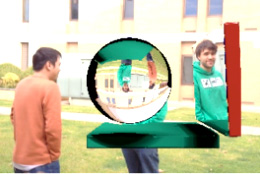22 January 2013
 A grant worth $122,000 has been awarded to researchers at the University of South Australia, to develop augmented reality (AR) technology on mobile phones, with qualities more advanced than those used for special effects in films.
A grant worth $122,000 has been awarded to researchers at the University of South Australia, to develop augmented reality (AR) technology on mobile phones, with qualities more advanced than those used for special effects in films.
A successful bid for funding by Dr Chris Sandor’s Magic Vision Lab research team has resulted in UniSA becoming the sole Australian university to be awarded a Samsung Global Research Outreach Program grant.
Dr Sandor says that while AR applications already exist that can be run on mobile phones, the poor quality of graphical information meant those applications had not gained broad user acceptance.
“In the project with Samsung, we will aim to dramatically improve rendering quality to achieve a quality of effects that can only be compared to special effects in movies.
“However, as special effects in movies can take several days to be generated by computers, the realtime constraints for AR applications require a rendering speed that's much faster, as whenever the phone moves, graphics have to be updated instantaneously.
“It is especially important that computer generated graphics blend better into the real environment; for example, by mimicking lighting conditions and shadows in the real world or refracting real world imagery when looking through transparent objects or reflections for glossy objects
“Our approach is to use realtime raytracing. Raytracing algorithms aim at the physically correct simulation of the traversal of light rays from light sources via intermediate surfaces to the camera.
“It will be possible for the phone user to move around and see the object they have created in the right perspective, with the right lighting, relative to where they are positioned.”
The implications and benefits of such technology being available on mobile phones would be considerable, especially for business and educational purposes.
Such an application could assist an architect in designing structures to fit in and complement natural surroundings, or could enable a tourist visiting a site of ancient ruins to “see” the historic site as it appeared in the past.
“Improving the user experience is pivotal in enabling augmented reality to become a commonly used feature on millions of mobile devices,” Dr Sandor says.
The awarding of the grant to the Magic Vision Lab research team marks the first time, since Samsung established the Global Research Outreach Program in 2009, Australian researchers have been among the winners.
Just 15 percent of submitted research proposals were accepted for funding by Samsung in 2012.
Contact for interview: Chris Sandor office 8302 5836
Media contact: Will Venn office 8302 0965 email Will.Venn@unisa.edu.au




